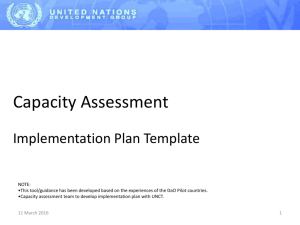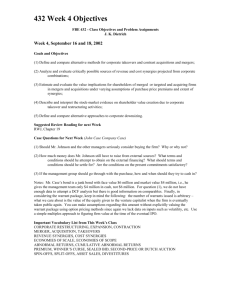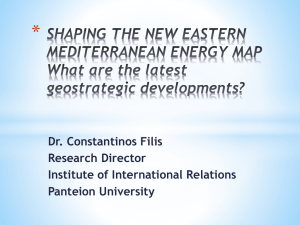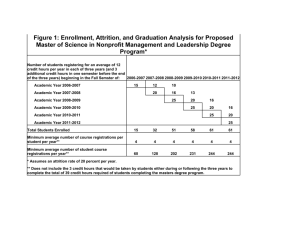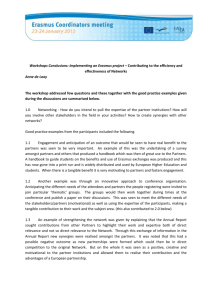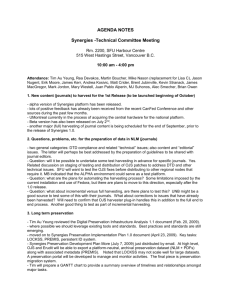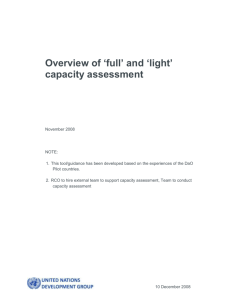Guidance note Options after the capacity assessment
advertisement
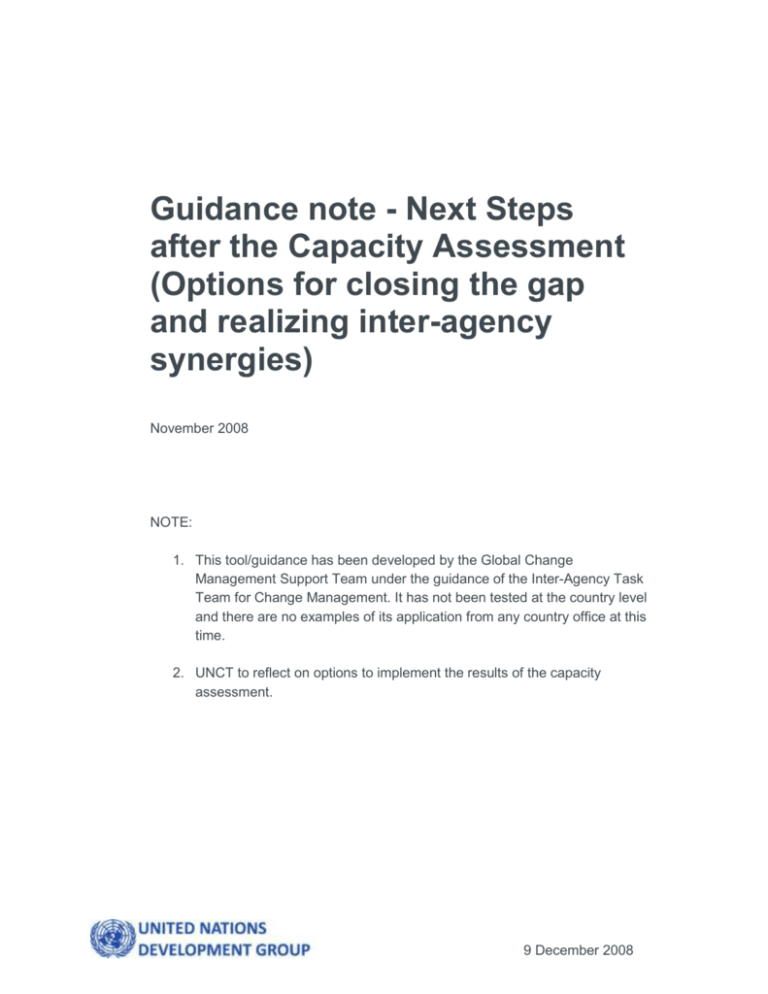
Guidance note - Next Steps after the Capacity Assessment (Options for closing the gap and realizing inter-agency synergies) November 2008 NOTE: 1. This tool/guidance has been developed by the Global Change Management Support Team under the guidance of the Inter-Agency Task Team for Change Management. It has not been tested at the country level and there are no examples of its application from any country office at this time. 2. UNCT to reflect on options to implement the results of the capacity assessment. 9 December 2008 Guidance note - Next Steps after the Capacity Assessment As a result of the capacity assessment, the UNCT will be able to quantify: 1) The capacity gap of the UN system both in terms of headcount and skills to deliver on short, medium, and possibly long term objectives of the UN system in the country 2) Potential resource synergies from inter-agency cooperation Through an implementation plan, the UNCT will address key activities and targets that will close both the capacity gap and realize synergies from cooperation. Critical to the success of the endeavour is an agreement that: - The capacity assessment is a UN system-wide exercise that yields results relevant at a country (rather than individual agency) level. Therefore, all subsequent discussion around capacity requirements needs to take place through a UN system-wide lens - Closing the gap and realizing the synergies are two distinct issues - They both require the identification of short as well as longer term measures to be taken. Short term measures serve to fix existing mismatches. Longer term measures address strategic capacity choices needed to meet external stakeholder capacity requirements in a changing development context. Overview of optional measures Please note that given the relatively new application of the capacity assessment exercise, few UN country teams have implemented the following options in their entirety. Instead, across UN country teams, distinct approaches have been taken to address specific cases as they have arisen and each country team has chosen their approach based on their country-specific context. Thus, the following table provides an overview of measures (which are not comprehensive) that could be taken to address the outcome of the capacity assessment. High-level summaries for each option follow. Short term Closing the gap a. Quantity gap: Hire additional staff (if budget allows) b. Skill gap: Rely temporarily on expert capacity (out-ofcountry, consultants, etc.) to build capacity among workforce Conduct gapspecific job matching exercise/job fair Realizing the synergies c. Natural attrition (conduct HR inventory ) iii Long term d. Quantity gap: Workforce planning (as part of HR strategy) e. Skill gap: (as part of HR strategy) Recruit the right profiles Deploy staff most efficiently Develop staff (capacity building) Encourage staff performance f. Create inter-agency clusters (according to HR strategy) Short term measures: a. Quantity gap: Hire additional staff. The capacity assessment gives an estimate of the required number and type of additional staff to be hired. Hiring additional staff entails mobilizing the required financial resources as well as finding and recruiting the right people. Since this may take time, an interim plan may need to be developed. b. Skill gap. In a job matching exercise/job fair, jobs are advertised and employees are invited to apply. This approach seeks to identify and appoint the best fit among the existing workforce for a particular position. Applicants will be requested to provide proof of their qualifications. It is recommended that such a job matching exercise / job fair be applied strategically to the gap-specific job needs that the UNCT identifies to minimize any disruption to implementation and delivery of the programme that such an exercise may cause. It will be difficult to build up capacity in the short run, so expert capacity may need to be consulted to bridge the gap. This expert capacity may be used to support the effort to build capacity in the long run. (For long run capacity building see below) c. Natural attrition. Wherever possible, resource synergies should be realized through natural attrition. An HR inventory will help to get a better picture of expected staff evolution. An HR inventory looks at staff demographics such as contract duration (in country) and the retiring date for each individual staff member. It provides information on expected staff turnover over time due to natural attrition. If it becomes apparent that natural attrition will not be sufficient to realize most of the potential synergies, other, employee friendly solutions may need to be taken into account (e.g. offering early retirement packages, supporting staff in the transition to a new employer, etc.) Long term measures All long term measures identified should be based on an HR strategy developed for the UN system in the country. Adhering to a thoughtfully developed HR strategy ensures adopting a consistent and fair approach that is in line with the overall objectives and the iv mission of the UN in the country. An HR strategy defines and plans for the optimal skill set of the UN system over time to deliver on its mission. The elements of the HR strategy could include but should not be limited to: HR planning to ensure staffing needs are fulfilled; recruiting, deploying and developing staff; motivating, rewarding, and recognizing staff. d. Quantity gap. In the long run, a quantity gap (and a skill gap) can be prevented through effective workforce planning. A workforce plan maps all resources and their position in present and future scenarios. It identifies upcoming resource requirements, establishes specific targets, and provides a detailed plan to meet those needs over a specific period of time e. Skill gap. In the long run, a skill gap can be prevented by recruiting the right profiles, deploying them most efficiently, developing staff so they remain competent in the context of a changing environment, and retaining the most qualified people. Recruiting the right profiles. This can refer both to recruiting people with high potential at an entry level who will grow in the organization as well as to hiring specialists with the profile to perform well in a given post. Developing staff (capacity building). Especially where candidates are recruited for their potential, capacity development through staff training will be essential. Different training needs of different types of staff need to be taken into account in developing a training strategy. Training should include both on and off the job training. Encourage staff performance. High staff performance needs to be encouraged through motivation, rewards and benefits. Developing a plan to systematically monitor, assess, recognize, and reward high-performing staff ensures a sense of fairness and provides role models that actively demonstrate UN excellence and professionalism. f. Create interagency clusters. The clustering of both programmatic and operational resources will allow for the realization of more synergies in the long run. For example, in common premises, where feasible, you could envision a clustering of functions providing gains in terms of efficiency and effectiveness as those who perform similar tasks learn from each other due to their proximity and close interaction. However, a strategic decision needs to be taken as to whether an inter-agency clustering is desirable. The HR strategy should address this issue and also look at the implications of clusters. For example, clustering might result in expert functions in contrast to generalist functions. If a small agency currently has 1 FTE to cover all HR related topics, an HR cluster could consist of a recruiting expert, a training and development expert, a compensation and benefits expert, a payroll expert, etc. v
